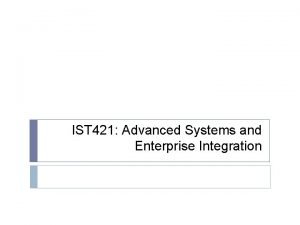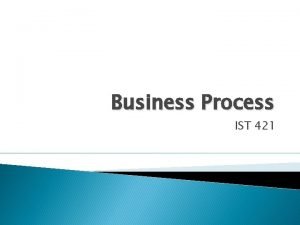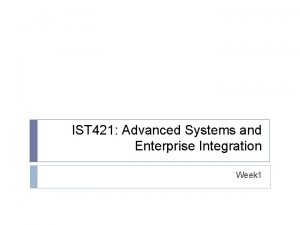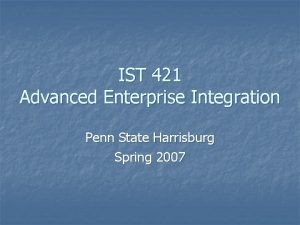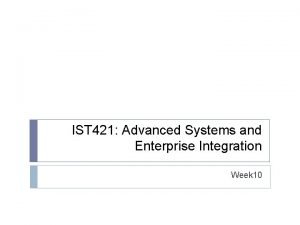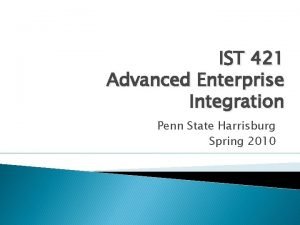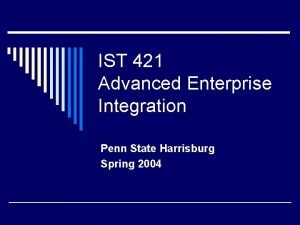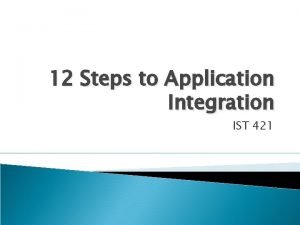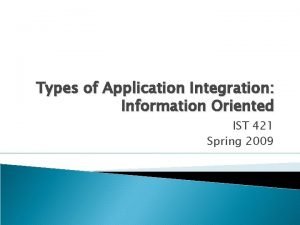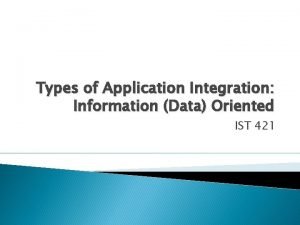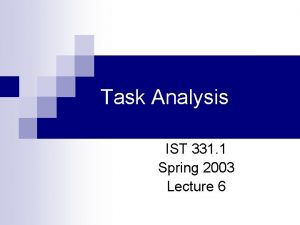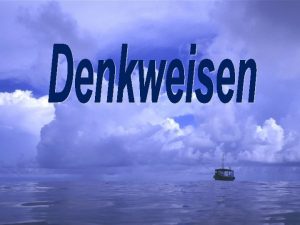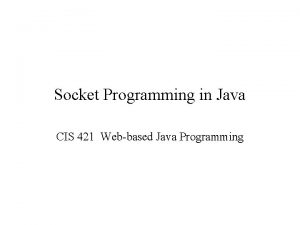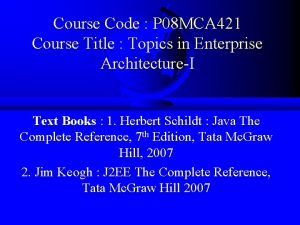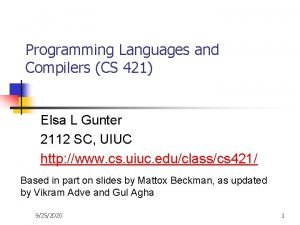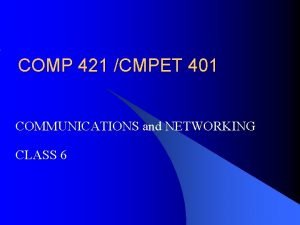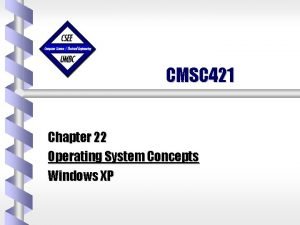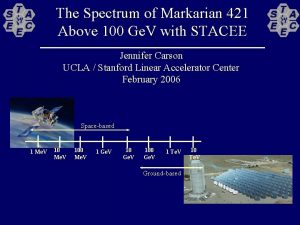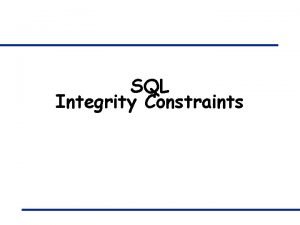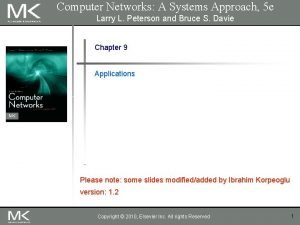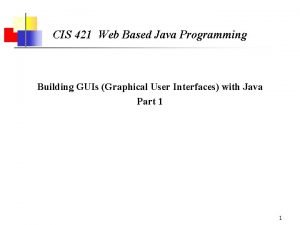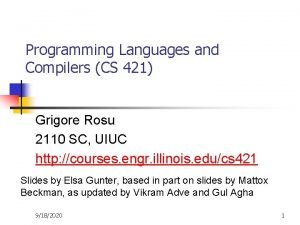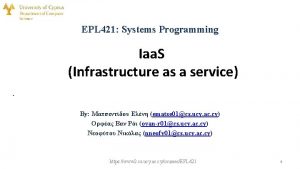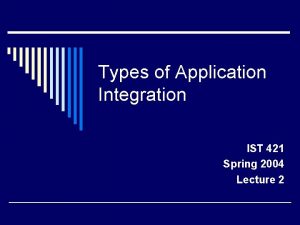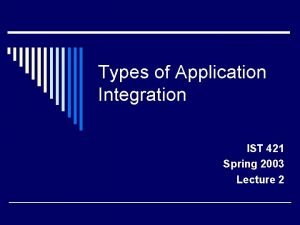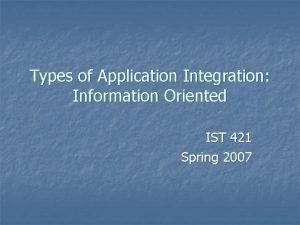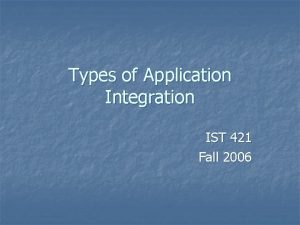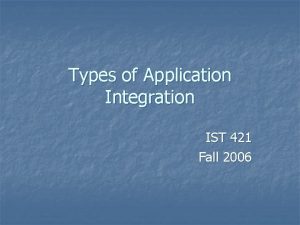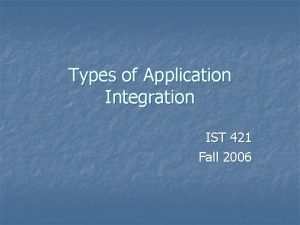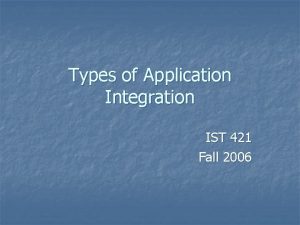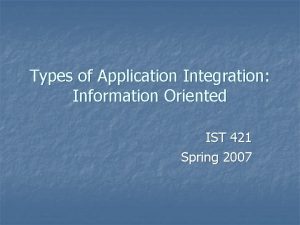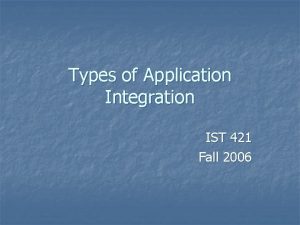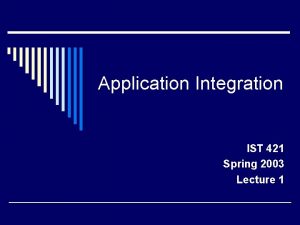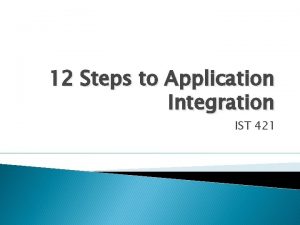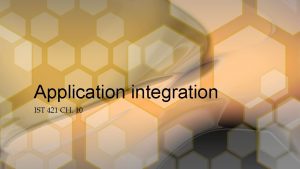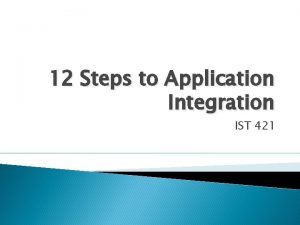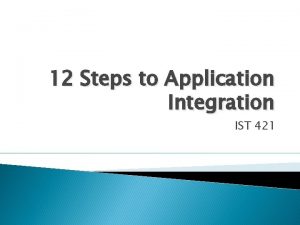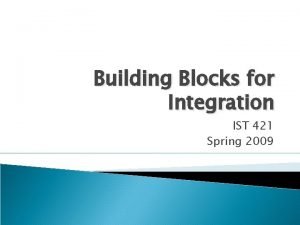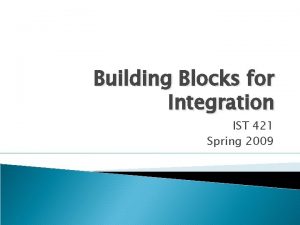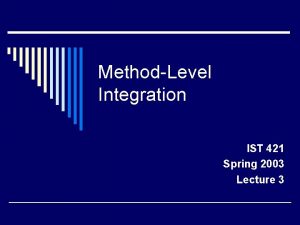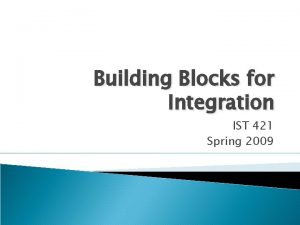Types of Application Integration IST 421 Spring 2004












































- Slides: 44

Types of Application Integration IST 421 Spring 2004 Lecture 2

o Enterprise integration should enable organizations to become more agile and flexible. This means: n n Continuously monitor market demand Quickly respond by providing new products, services & information Quickly introduce new technologies Quickly modify business methods Lee, Siau, & Hong, Enterprise Integration with ERP and EAI, Communications Of the ACM, Vol. 46, Number 2, February 2003, 54 -60.

Data-Level Integration

Data-Level Integration o Advantages: n n n Tools and techniques currently exist Relatively easy Requires no changes to the application logic or database structure

Coupling o The act of bringing together o Binding logic with data o Problems: n n Creates one application and database out of many, each dependent on the other Over time, a change to any system means a change to the coupled systems as well

Cohesion o Act of “sticking” together o Applications and databases are independent o Changes to any source system should not affect the others o Integration solutions should be cohesive rather than coupled

Coupling vs. Cohesion o Systems can be added, changed or removed from a cohesive solution n Message brokers provide this infrastructure o For common business processes to be reused, coupling may be more valuable n n n Distributed objects Transaction processing monitors Application servers

Data-Level Example o A company that manufactures copper wiring would like to hook up the inventory control system, a client/server system using Power. Builder and Oracle, and the Enterprise Resource Planning (ERP) system using an Informix relational database.

Data-Level Example n n Only sales data will move When a sale is entered into the inventory control system, copy the new information to the ERP system to ensure availability of raw material. Frequency of data movement – real time Choose method for moving data

Data-Level Example o Replication and Transformation Solution n Move information between different types of databases, i. e. , Sybase, Oracle, Informix n Move information between different models, i. e. , relational, object-oriented, multidimensional n Transforms data on the fly 09/17/62 Linthicum Dave Transform September 17, 1962 David Linthicum

Data-Level Integration o Database-to-Database n Replication solution – move data between databases with the same basic schema n Replication and Transformation solution o Advantages: n Simple n Low risk n Reduces cost o Problems: n Application logic may be bound to the data, i. e. , SAP R/3.

Data-Level Integration o Federated Database o “Virtual” Database n n Single point of application integration Access data from any number of databases, using various brands, models, and schemas

Data-Level Integration o Advantages: n n Middleware to share information between applications Hides the difference in the integrated databases o Problems: n n Need to create logic for integrating the applications with the database Not considered a true integration approach

Data Source to Consider o Relational databases o IDMS o IMS o VSAM o ISAM o Flat files

Application Interface Level

Application Interface Level o Application Interfaces – gain access to levels or services of an application o Application Programming Interfaces (APIs) –well-defined mechanisms to connect to resources such as an application server, middleware layer, or database.

Application Interface Level o Java’s RMI (Remote Method Invocation) o CORBA (Common Object Request Broker Architecture) o IIOP (Internet Inter-ORB Protocol) o Microsoft’s COM+ (Component Object Model)

Application Interface Level Example o A company has 2 systems: a new ERP system and a custom COBOL system. Each system runs on its own processor, connected to the corporate network.

Application Interface Level Example o ERP vendor provides APIs that work within C++, C, and Java. o Libraries that drive the API downloadable from vendor’s web site.

Application Interface Level Example Get. Invoice. Information(“ 12345”); <BOM> John Smith 222 Main Street Smalltown, VA 88888 Invoice Number: 123435 001 Red Bricks 1000 <EOM> . 50 500. 00

Application Interface Level Example Get. Customer. Information(“cust_no”); Quantity. Available(“product_no”);

Application Interface Level Example o COBOL system, no API exists. o Build an API – expensive o Select the right middleware to bind the ERP API on one side and the custom application API on the other side. n n n Message brokers Message-queuing middleware Application servers o Interfaces in this example provide access to both data and business processes

Packaged Applications o SAP, People. Soft, Oracle, Baan n n Business critical applications Accounting Inventory Human resources Manufacturing

Packaged Applications o Centralized Architecture

Packaged Applications o Two-Tier Architecture – 3 distinct layers n n n The user interface layer The business logic layer The data layer Fat Client

Packaged Applications o Two-Tier Architecture – 3 distinct layers n The user interface layer n The business logic layer Thin Client n The data layer

Packaged Applications o Three-Tier Architecture n n Most popular Scalable

Application Interface Level o Architecture has direct relationship with application interfaces n n Many packaged applications allow direct access to the database by using the business logic or application layer Understanding the architecture presents the opportunities for integration

Packaged Application APIs o Types of services n Business service – interfaces to any piece of business logic within the application; provide integrity controls for the data n Example: Update the database with new customer information from another application, business services would allow you to invoke the “customer update business service” from the API

Packaged Application APIs o Types of services n n Data service – direct route to the logical or physical database; generally for exporting data Objects – data and business services bound as objects; offer an advantage of maintaining integrity checks set up by the packaged applications

Vertical Market APIs o Provide access to industry-specific applications o SWIFT (Society for Worldwide Interbank Financial Telecommunications) n n Messaging standard Owned by member banks, including the central banks of most countries

Vertical Market APIs o FIX (Financial Information Exchange) n n Messaging service for real-time electronic exchange of securities transactions Evolved FIXML to give structure and valid grammar using XML to standard messages o HL 7 (Health Level 7) n Standard for electronic data exchange of health care information

Method-Level Integration

Method-Level Integration o Allows the enterprise to integrate through sharing common business logic or methods. n n Define methods that can be shared by multiple applications - reused Infrastructure for method sharing needed

Method-Level Integration o Requires most applications be changed in order to take advantage of method sharing n n n Change application Test the changed application Integrate Redeploy the application $$$$$

Method-Level Integration Example o Two Applications: n n C++ application running on Linux Client/server Java application on NT with Sybase database o Applications need to be tightly coupled to share business logic - Composite Application

Method-Level Integration Example o Rebuild the applications in one of two ways: n n Move business logic to shared server Rebuild each application using methodsharing mechanism p Distributed object technology which allows remote sharing of methods: CORBA COM+ Work intensive process!!

Method-Level Integration o Four types of processes: n n Rules – set of conditions that have been agreed upon. Rules are built into applications to control the flow of information. Example: travel reimbursement requests must be made within 30 days of returning from a trip

Method-Level Integration n Logic – sequence of instructions in a program Example: if button is pushed, then screen pops up 3 Classes of Logic: p Sequential processing p Selection p Iteration

Method-Level Integration n n Data – sharing information between applications, computers or humans Objects – bundles of data encapsulated inside an object and surrounded by methods that act upon the data p C++ p Java

Method-Level Integration o Frameworks – abstract classes and their object collaboration. Object-oriented programming supports software reuse, frameworks support design reuse. n n Fully debugged and tested software subsystems Centrally located and accessible by many applications Provide infrastructure for sharing methods – provide objects that are accessible by a number of applications Provide reuse throughout an industry where many processes are the same

Enabling Technology o Application or Transaction Servers – transaction processing monitors for high volume systems n n n Web. Logic Kiva (Netscape Application Server) Net Dynamics

Enabling Technology o Distributed Objects n n Component Object Model (COM+) Common Object Request Broker Architecture (CORBA)

Limits on adoption of this Technology o Political reasons are a primary reason for limited adoption of this technology n n n Internal politics Inability to select a consistent technology set Most invasive level of B 2 B integration
 Ist 421
Ist 421 Process integration definition
Process integration definition Ist 421
Ist 421 Ist 421
Ist 421 Advanced systems integration
Advanced systems integration Ist 421
Ist 421 Ist 421
Ist 421 Ist 421
Ist 421 Information oriented
Information oriented Information-oriented application integration
Information-oriented application integration Bae yong-kyun
Bae yong-kyun Spring what months
Spring what months Ist spring design and validation
Ist spring design and validation Analysisist
Analysisist Winter kommt winter kommt flocken fallen nieder
Winter kommt winter kommt flocken fallen nieder Meine lieblingsjahreszeit ist der winter
Meine lieblingsjahreszeit ist der winter Ich habe heute klassendienst
Ich habe heute klassendienst Es ist herbst es ist herbst bunter blätter fliegen
Es ist herbst es ist herbst bunter blätter fliegen Zu glauben ist schwer. nichts zu glauben ist unmöglich
Zu glauben ist schwer. nichts zu glauben ist unmöglich Forward integration and backward integration
Forward integration and backward integration Vertical integration
Vertical integration Simultaneous integration
Simultaneous integration 421 could not create socket
421 could not create socket Cs 421
Cs 421 Pediatric fluids 4 2 1
Pediatric fluids 4 2 1 Here is where your presentation begins
Here is where your presentation begins Rule4ml
Rule4ml Estimated blood volume
Estimated blood volume 4 2 1 fluid rule
4 2 1 fluid rule Cse 421
Cse 421 Fwm 421
Fwm 421 Fwm 421
Fwm 421 Cs 421 uiuc
Cs 421 uiuc Comp421
Comp421 Cmsc 421
Cmsc 421 Markarian 421 transmission
Markarian 421 transmission Biba n 421 ddl
Biba n 421 ddl Cs421 bilkent
Cs421 bilkent Me 421
Me 421 Me 421
Me 421 Jrootpane
Jrootpane Psy 421
Psy 421 Cs 421 uiuc
Cs 421 uiuc Cs 421 programming languages and compilers
Cs 421 programming languages and compilers Epl421
Epl421
